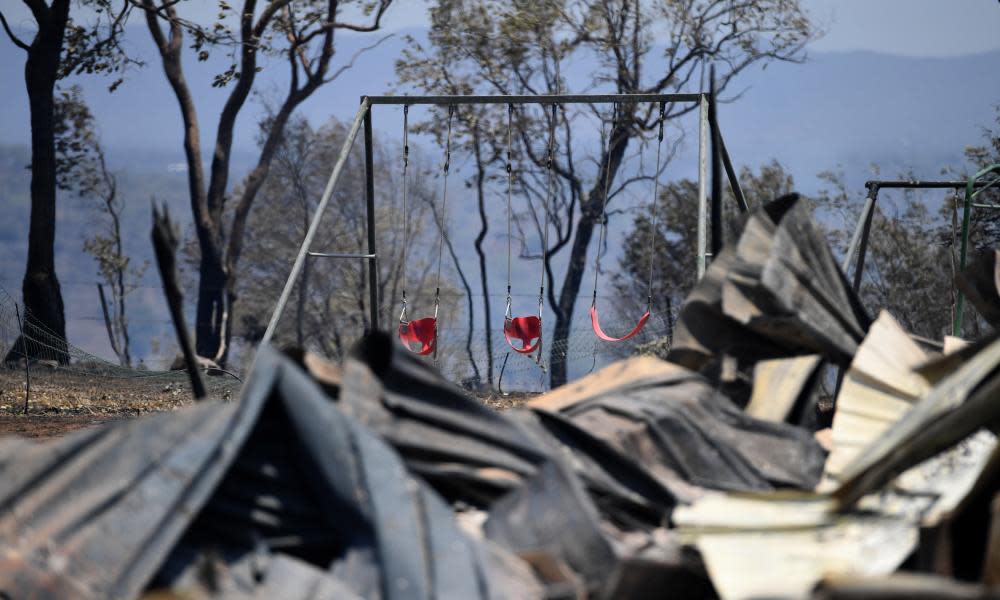Climate change made extreme heat before 2018 Queensland bushfires 'four times more likely'

Extreme temperatures that helped drive historic 2018 bushfires in north Queensland were four times more likely to have happened because of human-caused climate change, according to a study to be published next month.
Scorching conditions in November 2018 sparked Queensland’s biggest ever firefighting response as 1,250 fires torched 1.4 million hectares, destroying nine homes and causing widespread impacts across multiple farming industries.
The peer-reviewed study, led by University of New South Wales climate scientist Dr Sophie Lewis, is one of the first in Australia to demonstrate the influence of extra greenhouse gases in the atmosphere on a single bushfire event.
Related: Climate change makes bushfires worse. Denying the truth doesn't change the facts | Richard Denniss
To be published in a major US journal next month, the study examined the conditions leading up to the fires and, using models, tested whether those conditions were more likely under the enhanced greenhouse conditions that now exist in the atmosphere.
“We tried to pull apart the key ingredients in those conditions and then see if they were influenced by climate change,” Lewis said. “In that one bushfire event, there were so many people affected and it has had huge negative outcomes on their lives. We are finding that some of the elements that contributed to the fires are being influenced by anthropogenic factors.”
Fire authorities and governments use the forest fire danger index (FFDI) to understand bushfire risk. The index combines heat, rainfall, humidity and wind to deliver a score where above 75 means the risk is “extreme” and above 100 means conditions are “catastrophic”.
The study looked at the components of the index, as well as examining the background weather conditions. According to Lewis’s findings, the number of days of very high FFDI ratings in the fire region was unprecedented in data going back to 1950.
Lewis said: “Temperature is a very important aspect in the forest fire danger index and we really do think that the enhanced temperatures is what differentiated that 2018 event from previous years.”
The study found that the November temperatures in the Queensland region affected by the fire were more than four times more likely to occur because of human-caused climate change.
The study co-authors included scientists from the Bureau of Meteorology and the University of Melbourne.
The study says: “The 2018 conditioning heatwave event was more severe and persistent than previous analogues, with no event of this scale previously occurring at such northerly locations.
“Events that are unprecedented in a given region, such as the 2018 event, reveal that firefighting preparation and training cannot rely on previous events as guidance for the most dangerous conditions they can expect in the current and future climate where large-scale fires occur more regularly.”
Related: Longer fire seasons threaten to disrupt US-Australia firefighting cooperation
Lewis said the study found that human-caused climate change had probably also influenced the drier spring conditions in the area affected by the fires, but this link was much less pronounced.
The Queensland government responded with a recovery plan after the fires, using $30m from a joint commonwealth and state funded disaster recovery scheme.
Some 4,202 fire personnel, including more than 100 from interstate, responded to the fires at their peak – the largest firefighting response in Queensland’s history. More than 14,000 people were asked to evacuate.
In October, the National Environmental Science Programme released new scientific guidance on bushfires, stating that human-caused climate change had “already resulted in more dangerous weather conditions for bushfires in recent decades for many regions of Australia”.
Increasing greenhouse gas emissions would further accelerate the trends towards more dangerous conditions, the guidance said.
Two studies published in recent months – one in the journal Geophysical Research Letters and another in Scientific Reports – have found that climate change will increase the risk of the most extreme bushfires.
These pyrocumulonimbus fires – named after the clouds they create – can push hot air many kilometres up, creating their own unpredictable winds, storms and lightning, presenting a dangerous challenge for firefighters.

 Yahoo News
Yahoo News 
